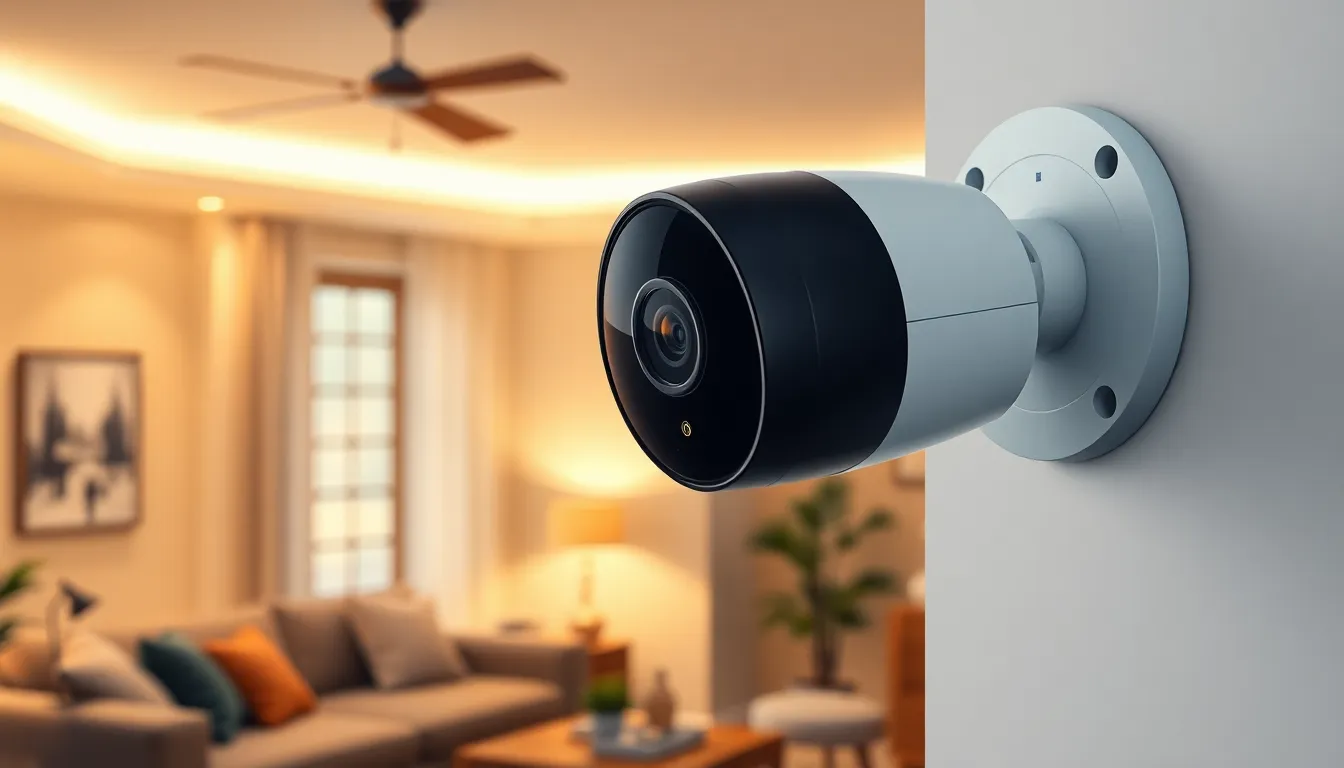In a world where even your neighbor’s cat has its own Instagram account, it’s time to step up your home security game. Home security cameras aren’t just for the paranoid; they’re your first line of defense against unwanted guests and unexpected surprises. Imagine knowing what’s happening around your home while you’re busy binging your favorite show.
Installing these cameras might seem like a daunting task, but fear not! With a little guidance, anyone can transform their home into a fortress without breaking a sweat—or the bank. So grab your toolbox and get ready to turn your living space into a high-tech haven. After all, who wouldn’t want to keep an eye on their property while enjoying a slice of pizza on the couch? Let’s dive into the world of home security camera installation and make your home a safer place, one camera at a time.
Table of Contents
ToggleOverview of Home Security Cameras Installation
Home security cameras offer a straightforward method to bolster safety. Choosing the right location is crucial. Key areas include entrances, driveways, and common areas inside the home. The selection of camera type impacts performance. Options include dome, bullet, and PTZ cameras, each suitable for different situations.
Installation methods vary depending on the camera type. Wireless cameras simplify the process by reducing wiring efforts. Wired cameras often provide reliable connections, especially for high-definition video. Mounting cameras at the appropriate height ensures optimal coverage. Additionally, avoiding obstructions can enhance the camera’s field of vision.
Understanding the power source is essential for functionality. Battery-operated cameras provide flexibility, while wired models require access to power outlets. Connectivity options also matter. Wi-Fi cameras rely on strong internet signals, while hardwired systems connect directly to a network.
Configuring settings enhances camera efficiency. Users can adjust motion detection zones and video quality for customized monitoring. Notifications keep homeowners alert about any activity. Cloud storage and local recording options ensure that footage is accessible when needed.
Testing the system after installation delivers peace of mind. Conducting periodic reviews of camera effectiveness helps maintain security. Regularly updating software strengthens cybersecurity defenses. By prioritizing installation and configuration, homeowners can create a robust security environment tailored to their needs.
Types of Home Security Cameras

Home security cameras come in various types, each designed for specific monitoring needs.
Indoor Cameras
Indoor cameras monitor the interior of a home. They help capture activity and provide peace of mind while homeowners are away. Smaller in size, these cameras often blend seamlessly with home decor. They feature motion detection and two-way audio capabilities, allowing for real-time communication. Some models include night vision, ensuring visibility in low-light conditions. Popular brands such as Arlo and Nest provide reliable options for indoor surveillance.
Outdoor Cameras
Outdoor cameras are built to withstand weather elements and provide surveillance of exterior areas. They feature weatherproof casings and often include infrared night vision for effective monitoring after dark. Key locations for installation include driveways, patios, and entrances. Many outdoor models come with added features such as sirens and spotlight alerts for enhanced security. Brands like Ring and Lorex offer robust solutions suitable for various outdoor settings.
Wired vs. Wireless
Wired security cameras connect directly to a home’s electrical system for stable performance. They often require professional installation, which can be more complex than wireless options. Wireless cameras, on the other hand, use Wi-Fi to transmit footage, simplifying installation and offering flexibility in placement. However, they rely on strong internet connections. Deciding between wired and wireless options depends on specific needs, including location, installation preferences, and connectivity concerns.
Preparation for Installation
Preparation plays a critical role in ensuring successful home security camera installation. Making informed decisions enhances the overall effectiveness of the surveillance system.
Assessing Your Security Needs
Identify specific vulnerabilities around the home. This step involves evaluating entry points like doors and windows, as well as commonly traveled areas. Assessing crime statistics in the neighborhood can also provide valuable insights into where cameras are most necessary. Determine whether indoor, outdoor, or both types of cameras are required. Prioritize high-risk zones for additional coverage, as having a clear understanding of security needs significantly improves the final setup.
Choosing the Right Location
Selecting locations for camera installation is essential for optimal coverage. Position cameras at main entrances to capture clear images of individuals approaching the home. High-traffic areas, like driveways and backyards, also warrant attention for surveillance. Ensure that no obstructions block the camera view, and consider lighting conditions, especially for outdoor cameras with night vision capabilities. Mounting cameras at least eight to ten feet above the ground boosts their effectiveness while decreasing the chance of tampering.
Installation Process
Home security camera installation involves careful planning and execution to achieve optimal protection. Thorough preparation ensures effective coverage and a secure environment.
Tools Required
Tools for camera installation include a drill, screwdriver, ladder, level, and measuring tape. A power source should be readily available for powered cameras. Fasteners and anchors ensure secure mounting. Additionally, a smartphone or computer aids in configuring the camera’s settings.
Step-by-Step Installation Guide
Begin by determining the ideal locations for the cameras based on vulnerabilities around the home. Measure distances to ensure proper camera coverage of entry points and high-risk areas. Next, mount the cameras at a height of eight to ten feet, minimizing tampering risks. If using wired cameras, run the cables carefully, avoiding potential hazards. Once installed, configure the settings through the accompanying app or software. Finally, conduct a test to confirm functionality and adjust as needed for optimal surveillance.
Maintenance and Troubleshooting
Maintaining home security cameras ensures reliable performance and longevity. Regular checks can prevent issues that impede security.
Regular Maintenance Tips
Inspect cameras monthly for signs of wear and damage. Clear dust or debris from lenses to maintain clear video quality. Tighten screws and connections as needed to ensure stability. Check the power source frequently; replace batteries in battery-operated cameras every three to six months. Continuous updates to firmware improve security features and overall functionality. Review recorded footage regularly to ensure the system is capturing as intended. Clean camera housings with a soft cloth to avoid scratches and maintain visibility.
Common Issues and Solutions
Intermittent connectivity often arises from weak Wi-Fi signals. Place Wi-Fi extenders near the camera locations to enhance signals. Blurry images may result from dirty lenses; cleaning them resolves this quickly. In cases of motion detection failures, check the settings to confirm they are activated. Restart the camera to resolve unexpected software glitches. If recording isn’t functioning, examine storage capacity and clear space as necessary. Connectivity alerts may arise; resetting the camera can often restore the connection.
Investing in home security cameras is a proactive step towards protecting one’s home and loved ones. With the right planning and installation, these cameras can significantly enhance safety and peace of mind. By carefully assessing vulnerabilities and selecting suitable camera types and locations, homeowners can create a comprehensive security system tailored to their needs.
Regular maintenance and updates ensure that the system remains effective over time. As technology evolves, staying informed about advancements in security features can further bolster protection. Embracing this technology not only safeguards the home but also allows for a more relaxed lifestyle knowing that security is a priority.








